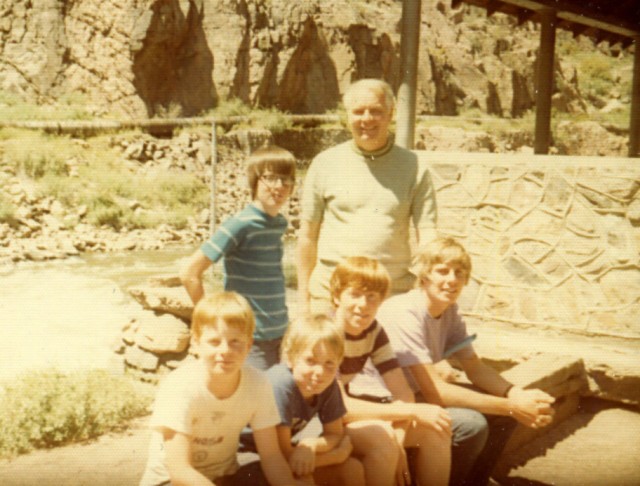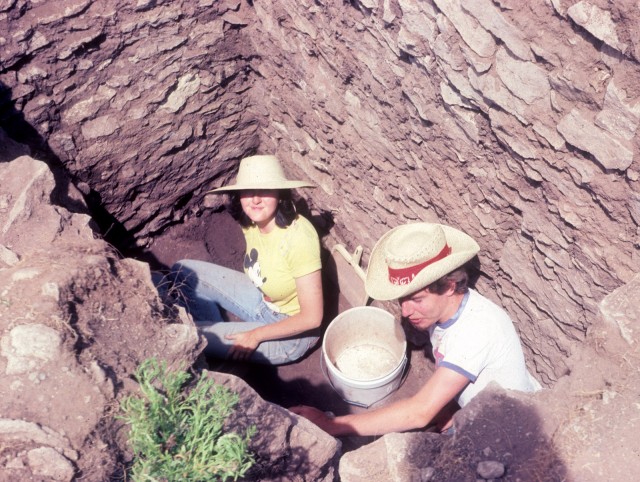- Home
- >
- Preservation Archaeology Blog
- >
- Deep Roots and Archaeological Obsession

(October 14, 2015)—My roots as an archaeologist extend back to 1976 and my 6th grade social studies class in Denver. We were learning about recent paleoanthropological discoveries in East Africa. The work of anthropologists Donald Johanson (who found the famous Lucy skeleton) and Louis Leakey was making news with amazing findings about the early ancestors of humanity. I was enthralled! As a young student, social studies—particularly history—was always my favorite class. Deeper history, archaeology, and anthropology, represented by studies of very ancient humans, became a fascination for me.

My burgeoning love of archaeology was fostered by a number of summer trips my family made around the Southwest in the 1970s. In particular, visits to Aztec Ruins and Taos Pueblo stood out. As a senior in high school, I tried to take my first anthropology class, but it was cancelled because the minimum number of students had not signed up. As a result, my formal education in anthropology had to wait until my freshman year at Whitman College. About a week into the introductory class, I knew I wanted to major in anthropology. It was clear that I loved to learn about humanity, particularly in the past, and that I had a deep passion for this type of knowledge.
The final pull into archaeology was my attendance at the 1984 Rowe field school, jointly conducted by the University of New Mexico (UNM) and New Mexico State University (NMSU). I showed up at Rowe Pueblo, south of Pecos National Historical Park, with only a year of college under my belt, but ready to dive into archaeology. Rowe Pueblo is 300-room Pueblo IV village that was abandoned about A.D. 1375, with its population inferred to have joined the growing Pecos Pueblo. The project was directed by Linda Cordell (UNM), Fred Plog (NMSU), and Steadman Upham (NMSU).

All three of these archaeologists made substantial contributions to the field. Fred Plog passed too early, with a full lifetime’s worth of publications by age 46. Linda died just two years ago and left an enduring legacy in Southwestern archaeology, as a first-class researcher and mentor to dozens. Linda completed the report on Rowe Pueblo in 1998: Before Pecos: Settlement Aggregation at Rowe, New Mexico, published by the Maxwell Museum at UNM. Steadman Upham has published more than ten books in archaeology and is currently President of the University of Tulsa.
To say that my six weeks at the Rowe Field School were transformative would be an understatement. The field school introduced me and the other undergraduates to all aspects of archaeology—excavation, survey, total station mapping, artifact washing, and cataloguing, as well as curation, preliminary laboratory analysis, and data entry. Most weekends were filled with field trips to nearby sites or ongoing archaeological projects (and a wee bit of late-night beer guzzling and spirited discussion!). Guest speakers—including illustrious figures Brian Fagan and Lewis Binford—gave lectures most Wednesday evenings. It is fair to describe the Rowe experience as full-immersion archaeology. I came away from Rowe convinced of my career path, and I’ve yet to step off that path, even 31 years later!
Returning to Whitman College in the fall of 1984, I decided quickly to transfer to NMSU at the end of my sophomore year. I enjoyed my time at Whitman, but the college lacked a major in anthropology-archaeology, and I wanted no delay in continuing my archaeological adventures. The anthropology department at NMSU was up and coming in 1985. I enjoyed all my classes and professors at NMSU, but I found Steadman Upham a particularly engaging instructor and supportive mentor. I finished my B.A. and M.A. degrees in just seven semesters at NMSU.
I also gained valuable experience working in the field of cultural resource management (CRM), or contract archaeology. The latter experience would land me a job with the Navajo Nation Archaeology Department (NNAD) in 1988, and helped launch my career in archaeology. I was employed by NNAD until 2001, when I began work at Salmon Ruins Museum, as the Center for Desert Archaeology’s (now Archaeology Southwest) Chaco Scholar and Preservation Archaeologist. Fourteen years later, I continue to work for Archaeology Southwest, pursuing archaeological research, preservation, and public outreach and education.
One thought on “Deep Roots and Archaeological Obsession”
Comments are closed.
I am a daughter of the Sandoval family. I was present for most of the 1980 excavations. I still wander the Pueblo and pick up bits.
I disagree with the dates of occupation of this site. I would love another field school there but unfortunately my dad thought it was all done . My mother is still alive. Maybe an inquiry would allow someone to continue research?